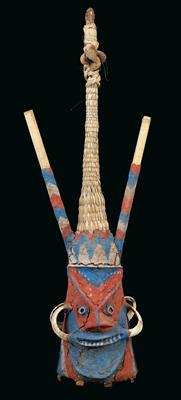Oceania, Vanuatu (formerly New Hebrides), Malekula Island: a Janus-faced helmet mask, called ‘Temes Malau’, with 2 faces, 4 boar’s tusks and 3 prongs in the upper section.
Oceania, Vanuatu (formerly New Hebrides), Malekula Island: a Janus-faced helmet mask, called ‘Temes Malau’, with 2 faces, 4 boar’s tusks and 3 prongs in the upper section.

A helmet or head crest mask from southern Malekula, called ‘Temes Malau’, Janus-faced, with one head on the front and one on the back, four boar’s tusks, as well as a high ‘hairstyle’ consisting of 3 spikes. This mask type, representing an important old man or an ancestor, ‘danced’ during initiations of the male secret society ‘Nalawan’ and was traditionally manufactured by the young initiates themselves. For a more detailed explanation concerning the use and significance of the present ‘Nalawan mask’ see cat. no. 201. The ‘Temes Malau’ mask presented here consists of a structure of bamboo staffs, tightly wrapped in light-coloured raffia strips, and additionally enveloped on the outside with a mixture of plant fibres and light grey clay. The soft, light grey clay mass was smoothed into flat surfaces on the outside and used to mould the two faces on the front and back: with eyebrows and small, round, protruding eyes, a wide nose and an open mouth. On either side of each of the two mouths, on the front and back, two large, curved boar’s tusks feature prominently as a symbol of strength, power and prosperity of the represented ancestor. Three spikes of bamboo cane project from the top of the mask as its ‘hairstyle’. The longer middle spike is tightly enveloped in light-coloured vegetable stripes and featuring four seeds, cut open and attached to the top, as ‘bells’. The mask was painted with red ochre, chalk (earth colours), black soot and ‘Reckitt’s Blue’, an imported pigment that was widespread throughout Oceania in the first half of the 20th century. An interesting specimen of Oceanic art, with understandable, material- and age-related damage (surface cracks). Feather tufts, which were originally attached to the three spikes on top, in keeping with tradition, are missing here. Otherwise it is in exceptionally good condition. Height: 104 cm; Width: c. 30 cm. First half of the 20th century. According to information supplied by the consigner, the present item was probably manufactured between 1930 and 1950. (ME)
Provenance:
Pursuant to information supplied by the consigner, the present item was acquired by a missionary on Malekula Island, Vanuatu, in 1950. Then: c. 1955 Michael Kuntz Private Collection, Dallas, USA. Then: private collection, Dr. Klaus Spiess, Vienna. Then: Austrian Private Collection.
Lit.:
‘Vanuatu. Kunst aus der Südsee’ by Christian Kaufmann, Museum der Kulturen Basel, ill. 160.
Specialist: Erwin Melchardt
 Erwin Melchardt
Erwin Melchardt
+43-1-515 60-465
erwin.melchardt@dorotheum.at
09.06.2016 - 17:00
- Realized price: **
-
EUR 2,000.-
- Starting bid:
-
EUR 1,600.-
Oceania, Vanuatu (formerly New Hebrides), Malekula Island: a Janus-faced helmet mask, called ‘Temes Malau’, with 2 faces, 4 boar’s tusks and 3 prongs in the upper section.
A helmet or head crest mask from southern Malekula, called ‘Temes Malau’, Janus-faced, with one head on the front and one on the back, four boar’s tusks, as well as a high ‘hairstyle’ consisting of 3 spikes. This mask type, representing an important old man or an ancestor, ‘danced’ during initiations of the male secret society ‘Nalawan’ and was traditionally manufactured by the young initiates themselves. For a more detailed explanation concerning the use and significance of the present ‘Nalawan mask’ see cat. no. 201. The ‘Temes Malau’ mask presented here consists of a structure of bamboo staffs, tightly wrapped in light-coloured raffia strips, and additionally enveloped on the outside with a mixture of plant fibres and light grey clay. The soft, light grey clay mass was smoothed into flat surfaces on the outside and used to mould the two faces on the front and back: with eyebrows and small, round, protruding eyes, a wide nose and an open mouth. On either side of each of the two mouths, on the front and back, two large, curved boar’s tusks feature prominently as a symbol of strength, power and prosperity of the represented ancestor. Three spikes of bamboo cane project from the top of the mask as its ‘hairstyle’. The longer middle spike is tightly enveloped in light-coloured vegetable stripes and featuring four seeds, cut open and attached to the top, as ‘bells’. The mask was painted with red ochre, chalk (earth colours), black soot and ‘Reckitt’s Blue’, an imported pigment that was widespread throughout Oceania in the first half of the 20th century. An interesting specimen of Oceanic art, with understandable, material- and age-related damage (surface cracks). Feather tufts, which were originally attached to the three spikes on top, in keeping with tradition, are missing here. Otherwise it is in exceptionally good condition. Height: 104 cm; Width: c. 30 cm. First half of the 20th century. According to information supplied by the consigner, the present item was probably manufactured between 1930 and 1950. (ME)
Provenance:
Pursuant to information supplied by the consigner, the present item was acquired by a missionary on Malekula Island, Vanuatu, in 1950. Then: c. 1955 Michael Kuntz Private Collection, Dallas, USA. Then: private collection, Dr. Klaus Spiess, Vienna. Then: Austrian Private Collection.
Lit.:
‘Vanuatu. Kunst aus der Südsee’ by Christian Kaufmann, Museum der Kulturen Basel, ill. 160.
Specialist: Erwin Melchardt
 Erwin Melchardt
Erwin Melchardt
+43-1-515 60-465
erwin.melchardt@dorotheum.at
|
Buyers hotline
Mon.-Fri.: 10.00am - 5.00pm
kundendienst@dorotheum.at +43 1 515 60 200 |
| Auction: | Tribal Art - Africa |
| Auction type: | Saleroom auction |
| Date: | 09.06.2016 - 17:00 |
| Location: | Vienna | Palais Dorotheum |
| Exhibition: | 04.06. - 09.06.2016 |
** Purchase price incl. buyer's premium and VAT
It is not possible to turn in online buying orders anymore. The auction is in preparation or has been executed already.
